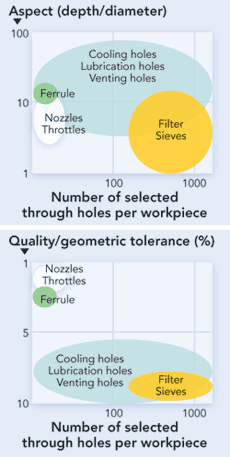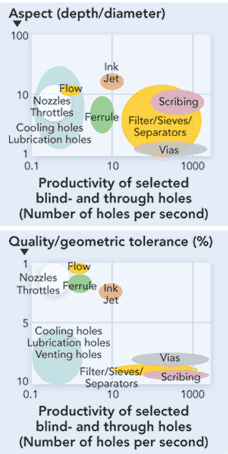by Ulrich Durr
Hole quality and productivity improvements expand the application opportunities for laser drilling
Drilling applications represent about 5% of industrial laser materials processing applications.1 Improving productivity has led to several drilling strategies with respect to the laser sources (thermal drilling and ablation drilling), beam handling, beam distribution, and handling of the workpiece, all of which contribute to the overall efficiency of the process and a high productivity.
Among the through hole applications are cooling holes in jet or gas turbines, lubrication holes in powertrain components, and holes in injection nozzles, air bearings, and shower heads. Also included are holes in filters, sieves, separators for powertrain, food- or non-food chemical engineering, and vent holes in castings.
Blind holes are used in surgical needles and for scribing as a first stage in cracking or separation strategy of brittle materials—already a standard process in connecting rods, bearings, and ceramic and sapphire substrates. Other applications are storage pockets for surface lubrication or drugs in medical implants and the increasing market for contacting strategies on crystalline solar cells or semiconductors.
This article concentrates on through holes with diameters between 0.01 and 1.5mm and aspect ratios (depth/diameter) between 1 and 30. Depending on the application, these holes require different geometries ranging from cylindrical to conical, slots or shaped holes.
FIGURE 1a shows the typical cylindrical geometries and tolerances for the selected applications dependent on the number of required holes per workpiece. FIGURE 1b shows these geometries and tolerances dependent on the productivity reached with solid-state lasers. These figures represent a qualitative survey of laser drilling. Specific side effects such as heat affected zone (HAZ), recast, microcracks, and roughness or burr depend on drilling and production strategy. These side effects have to be minimized to comply with the users' requirements and to compare to other drilling technologies like EDM.
Today the major task is to combine high productivity with the increasing demand for better geometric tolerances while reducing processing side effects. The appropriate technologies and strategies behind this can be partly derived from Figure 1a and Figure 1b. It is clear from these figures that there are application regimes with few holes per workpiece and short drilling time where feeding and positioning becomes a challenge for system engineering. On the other hand, efficient drilling strategies are required for time-consuming high aspect holes—when hundreds or thousands of holes are drilled per workpiece.
Industrial laser drilling strategies are single-pulse or percussion drilling, trepanning or helical drilling. Pulsed solid-state lasers or modulated or pulsed fiber lasers with pulse duration in the range of microseconds (thermal pulses) to picoseconds (non thermal pulses) are used.2 As a rule holes with lower quality requirements and higher aspect are drilled with thermal pulses. The lamp-pumped lasers delivering these pulses typically have pulse repetition rates below 5kHz. High-quality holes are drilled with short pulses with repetition rates typically above 100kHz.
With advanced optical beam steering technologies such as fast and precise rotating optics or galvos for thin materials (<1mm), high–speed, layer-by-layer “on contour” trepanning techniques are emerging using high brilliance diode-pumped solid-state or fiber lasers in the CW mode.3 This article will not elaborate on these remote trepanning strategies.
In all thermal drilling processes productivity has to be compromised with quality, especially thermal side effects like recast and microcracks. The influence of pulse shape and pulse modulation have been investigated with respect to drilling efficiency and hole quality.4 These investigations clearly show that there is potential for improvement of thermal drilling.
Single-pulse drilling
Holes with diameters of 0.015 to 1.2mm can be drilled using lamp-pumped pulsed industrial Nd:YAG solid-state lasers with an M2 between 3 and 60. FIGURE 2 shows a qualitative working range diagram giving the productivity as a function of aspect ratio and hole diameter. The aspect ratio of about 10 is shown. The productivity limit for high average power lasers is given by the available pulse repetition rate.
Insert (a) shows a 0.5mm-thick stainless-steel automotive filter requiring up to 1200 holes with a diameter of 0.05mm.These are drilled within about 2s. The prerequisite for this productivity is a fast rotating axis and other measures (e.g. backing) to achieve reproducible hole exit geometry and to avoid burr. Insert (b) is a 0.25mm (aspect 2.5) stainless-steel coffee machine component drilled at 30 holes/second. Insert (c) shows a piston ring with 0.7 mm hole diameters drilled with a 500W (pulse power 30kW) laser, at 30 holes/second. Typical tolerances are in the range of 5–10%.
Laser drilling is not limited to round holes as other shapes can be produced by proper optical elements in the laser beam. Compressed air (<6bar) is used as processing gas for most of these applications. For hole depths below 0.5mm and diameters below 0.04mm lamp-pumped systems at frequencies up to 5kHz are available. Even higher frequencies are possible with modulated CW fiber or disk lasers. Two limits for productivity are either the pulse (modulation) frequency or the “on the fly” speed, which has to be kept below the oval shape limit.5
Percussion drilling
For simplicity two regimes can arbitrarily be distinguished in FIGURE 3: low aspect holes where only few pulses are necessary (>1 hole/s) and deep holes, for example in turbine blades, requiring many pulses where production time is much longer than 1s. Here standard “stop and go” CNC or robot procedures are adequate. In many cases percussion drilling of deep holes produces severe recast depending on the material. If recast below 20% of the diameter is required, trepanning is the proper choice. In the productivity regime of >1 hole/second, “on the fly” percussion drilling can be applied: the CNC or robot is constantly moving and on each cycle only one pulse is delivered to the hole position and the number of cycles depend on the number of necessary percussion pulses to finish one hole. Such strategies are performed on the combustion chambers indicated in Figure 3b. Experiments have shown, that the drilling efficiency is approximately 10% lower because heat is lost during the cycle. In the stationary “stop and go” percussion strategy the temperature in the hole is high due to accumulation of the heat compensating heat conductivity losses. So it is up to the operator to determine the most efficient operation.
It is clear that parts with few <1.2mm holes with high aspect (>10) as in the vane (a), shown in Figure 3, can be drilled in the stationary percussion or trepanning mode, while parts like the combustion chamber (b) with thousands of holes and small aspect (<4) are most efficiently drilled “on the fly.” Insert (c) shows a percussion drilled food-compatible hard metal mincer component used to make Italian Mortadella where the taste of this sausage is influenced by the hole diameter.
Non-thermal percussion (ablation) drilling with ns or ps laser pulses on holes with diameter <0.2mm and aspect ratio <10 lead to better quality and reduced thermal side effects. At this time, these industrial lasers have limited average power and the processing time is not satisfactory. Suitable applications for ns lasers are air bearings, throttles, or contacting holes on crystalline solar cells.
Shaped holes
Shaped holes are becoming more popular. One may distinguish between holes like nozzles, where the complete hole is conically shaped with the help of CNC or flexible optical processing heads like those used in helical drilling and turbine cooling holes where the exit has a funnel shape to improve cooling with the same air flow resulting from cylindrical shapes. Simple conical shapes can be cut out with a ms pulse laser, while more complex shapes are produced by ns ablation lasers.6
Helical drilling
Helical drilling for cylindrical and conical holes is used where geometrical tolerances of <2% are required and thermal side effects like recast or HAZ are not tolerated, for example fuel injection nozzles. Even when combining a M2>1.5 ns pulsed laser with precise helical drilling optics, including additional rotation of the laser beam still leads to observable thermal side effects which are currently not accepted by the end customers.7 Efforts are being made to prove the suitability of ps lasers and improvements have been reported,8 but the technology and the process are still in the pre-industrial stage.
Summary
Single pulse and percussion drilling strategies with pulses from lamp-pumped solid-state lasers or in a limited way by modulated CW disk or fiber lasers have been improved with respect to quality and productivity but there is still room for improvement especially in the turbine markets where new material and thermal barrier coatings are being developed. Pulse forming or hybrid technologies could be a better choice. High brilliance lasers could find niches in remote gasless trepan-drilling. High power ps-pulse laser beams in combination with high dynamic and precise beam steering technologies could offer solutions for high productivity of small holes with negligible thermal side effects but still need industrial improvement.
Ulrich Dürr ([email protected]) is with LASAG AG (www.lasag.com), Thun, Switzerland.
References
- D. Belforte, “Laser Markets in the USA,” Laser Technik Journal, May 2008, page 10.
- K.Leong, “Power drilling,” Industrial Laser Solutions, page 11, May 2007.
- M.Lütke et al., “Remote-cutting material processing with high brightness lasers,” 4th Int. Workshop on Fiber Lasers 2008.
- R. Liebers et al., ”Drilling strategies for metals with pulsed lasers,” ICALEO 05, Congress Proceedings (2006).
- M. Baumeister, “FEM modelling of high speed laser micro-perforation “on the fly,” Proceedings of the 4th WLT Conference, page 715 (2007).
- R. Baxter, “Laser Drilling/Ablation of shaped holes in Turbine Components,” AKL 08, Int. Laser Technology Congress, Aachen 2008.
- R. Liebers et al., “Helical drilling with Q-switched Nd:YAG laser,” Proceedings of the 4th WLT-Conference, page 721 (2007).
- M.Kraus, “Microdrilling in steel with ultrashort laser pulses at 1064nm and 532nm,” Proceedings of the 4th WLT Conference, page 639 (2007).



